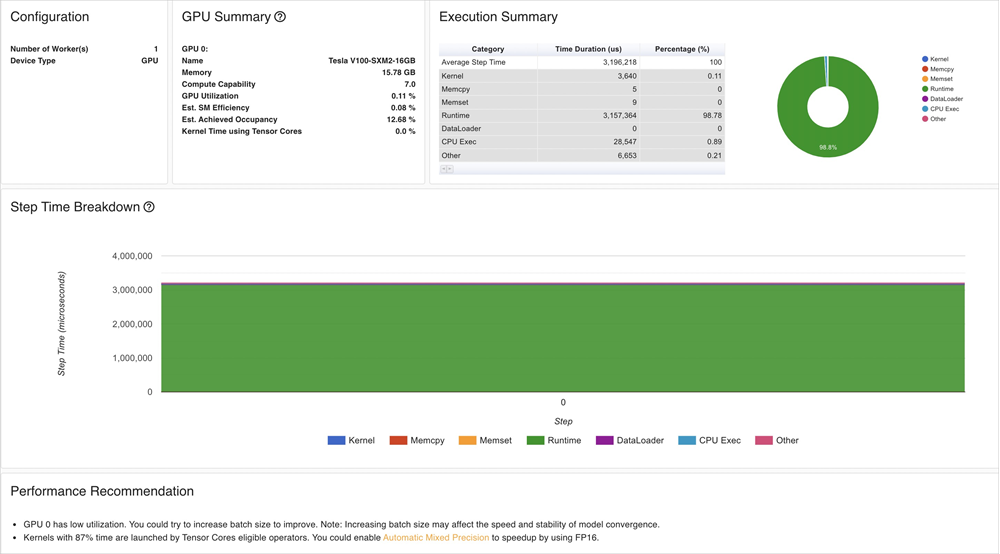本文以PyTorch官方提供的Resnet50模型為例,說明如何通過PyTorch Profiler發現模型的性能瓶頸,進而使用TensorRT優化模型,然后使用Triton Inference Server部署優化后的模型。
背景信息
Nvidia TensorRT是一個加速深度學習模型推理的SDK,包含可以降低推理時延、提高吞吐量的優化器和運行時。Triton Inference Server則是Nvidia官方推出的一個開源模型推理框架,可以支持PyTorch、Tensorflow、TensorRT、ONNX等主流的模型。
深度學習模型在訓練完成,準備部署上線時,通常需要對模型進行性能分析和優化,以便降低推理時延、提高吞吐量。同時可以減少模型占用的顯存,通過共享GPU,提高GPU的使用率。
本文以PyTorch官方提供的Resnet50模型為例,通過對下圖dog.jpg識別,說明如何通過使用PyTorch Profiler發現模型的性能瓶頸,進而使用TensorRT優化模型,然后使用Triton Inference Server部署優化后的模型。
前提條件
已創建包含GPU的Kubernetes集群。具體操作,請參見使用Kubernetes默認GPU調度。
集群節點可以訪問公網。具體操作,請參見為已有集群開啟公網訪問能力。
已安裝Arena工具。具體操作,請參見安裝Arena。
已為集群配置了Arena使用的PVC。更多信息,請參見配置NAS共享存儲。
步驟一:使用PyTorch模型的Profiler能力
PyTorch自1.8.1版本開始提供了Profiler能力,可以幫助分析模型訓練、推理過程中的性能瓶頸。并能與Tensorboard集成,方便查看分析報告。
執行以下命令,生成Profiler日志。
說明with open("imagenet_classes.txt") as f:中的imagenet_classes.txt文件,請參見imagenet_classes。import torch from torchvision import models import torchvision.transforms as T from PIL import Image import time #圖片預處理。 def preprocess_image(img_path): transform = T.Compose([ T.Resize(224), T.CenterCrop(224), T.ToTensor(), T.Normalize(mean=[0.485, 0.456, 0.406], std=[0.229, 0.224, 0.225]),]) #讀取圖片。 input_image = Image.open(img_path) #圖片格式轉換。 input_data = transform(input_image) batch_data = torch.unsqueeze(input_data, 0) return batch_data #預測結果后處理。 def postprocess(output_data): #讀取Imagenet分類數據。 with open("imagenet_classes.txt") as f: classes = [line.strip() for line in f.readlines()] #通過Softmax得到可讀的預測結果。 confidences = torch.nn.functional.softmax(output_data, dim=1)[0] * 100 _, indices = torch.sort(output_data, descending=True) i = 0 #打印預測結果。 while confidences[indices[0][i]] > 0.5: class_idx = indices[0][i] print( "class:", classes[class_idx], ", confidence:", confidences[class_idx].item(), "%, index:", class_idx.item(), ) i += 1 def main(): model = models.resnet50(pretrained=True) input = preprocess_image("dog.jpg").cuda() model.eval() model.cuda() with torch.profiler.profile( activities=[ torch.profiler.ProfilerActivity.CPU, torch.profiler.ProfilerActivity.CUDA, ], on_trace_ready=torch.profiler.tensorboard_trace_handler('./logs'), profile_memory=True, record_shapes=True, with_stack=True ) as profiler: start = time.time() output = model(input) cost = time.time() - start print(f"predict_cost = {cost}") postprocess(output) profiler.step() if __name__ == '__main__': main()使用Tensorboard查看分析報告。
執行以下命令安裝PyTorch Profiler Tensorboard Plugin并在本地啟動Tensorboard。
pip install torch_tb_profiler tensorboard --logdir ./logs --port 6006在瀏覽器地址欄輸入localhost:6006查看Tensorboard分析結果。
使用Tensorboard可以查看GPU Kernel、PyTorch Op、Trace Timeline等分析結果,進而給出優化建議。

從Tensorboard分析結果可得:
該Resnet50模型的GPU利用率比較低,可以考慮通過增大
Batch size的方式提高利用率。大部分時間消耗在GPU Kernel加載上,可以通過降低精度的方式提高推理速度。
步驟二:優化PyTorch模型
通過TensorRT優化模型時,需要先把PyTorch模型轉為ONNX,再把ONNX轉換成TensorRT Engine。
執行以下命令,導出ONNX。
#加載預訓練模型。 model = models.resnet50(pretrained=True) #預處理階段。 input = preprocess_image("dog.jpg").cuda() #推理階段。 model.eval() model.cuda() #轉換為ONNX。 ONNX_FILE_PATH = "resnet50.onnx" torch.onnx.export(model, input, ONNX_FILE_PATH, input_names=["input"], output_names=["output"], export_params=True) onnx_model = onnx.load(ONNX_FILE_PATH) #檢查模型是否轉換良好。 onnx.checker.check_model(onnx_model) print("Model was successfully converted to ONNX format.") print("It was saved to", ONNX_FILE_PATH)構建并導出TensorRT Engine。
重要構建TensorRT Engine時,依賴的TensorRT及CUDA版本,要與步驟四:部署優化后的模型使用Triton部署模型推理任務時的版本保持一致,同時也要和ECS實例的GPU Driver、CUDA版本一致。
建議直接使用Nvidia提供的TensorRT鏡像,這里使用的鏡像版本為
nvcr.io/nvidia/tensorrt:21.05-py3,對應的Triton鏡像為nvcr.io/nvidia/tritonserver:21.05-py3。def build_engine(onnx_file_path, save_engine=False): if os.path.exists(TRT_ENGINE_PATH): #如果存在序列化引擎,請加載該引擎,而不是構建新引擎。 print("Reading engine from file {}".format(TRT_ENGINE_PATH)) with open(TRT_ENGINE_PATH, "rb") as f, trt.Runtime(TRT_LOGGER) as runtime: engine = runtime.deserialize_cuda_engine(f.read()) context = engine.create_execution_context() return engine, context #初始化TensorRT引擎并解析ONNX模型。 builder = trt.Builder(TRT_LOGGER) explicit_batch = 1 << (int)(trt.NetworkDefinitionCreationFlag.EXPLICIT_BATCH) network = builder.create_network(explicit_batch) parser = trt.OnnxParser(network, TRT_LOGGER) #允許TensorRT使用高達1 GB的GPU內存進行策略選擇。 builder.max_workspace_size = 1 << 30 #本示例批處理中只有一個圖像。 builder.max_batch_size = 1 #請盡可能使用FP16模式。 if builder.platform_has_fast_fp16: builder.fp16_mode = True #解析ONNX。 with open(onnx_file_path, 'rb') as model: print('Beginning ONNX file parsing') parser.parse(model.read()) print('Completed parsing of ONNX file') #生成針對目標平臺優化的TensorRT引擎。 print('Building an engine...') engine = builder.build_cuda_engine(network) context = engine.create_execution_context() print("Completed creating Engine") with open(TRT_ENGINE_PATH, "wb") as f: print("Save engine to {}".format(TRT_ENGINE_PATH)) f.write(engine.serialize()) return engine, context對比原來的PyTorch模型與經過TensorRT優化后模型的Latency及Size。
執行以下命令,計算原始PyTorch模型在GPU上的推理耗時。
model = models.resnet50(pretrained=True) input = preprocess_image("dog.jpg").cuda() model.eval() model.cuda() start = time.time() output = model(input) cost = time.time() - start print(f"pytorch predict_cost = {cost}")執行以下命令,計算優化后的TensorRT Engine在GPU上的推理耗時。
#初始化TensorRT引擎并解析ONNX模型。 engine, context = build_engine(ONNX_FILE_PATH) #獲取輸入和輸出的大小,并分配輸入數據和輸出數據所需的內存。 for binding in engine: if engine.binding_is_input(binding): # we expect only one input input_shape = engine.get_binding_shape(binding) input_size = trt.volume(input_shape) * engine.max_batch_size * np.dtype(np.float32).itemsize # in bytes device_input = cuda.mem_alloc(input_size) else: #輸出。 output_shape = engine.get_binding_shape(binding) #創建頁面鎖定的內存緩沖區(即不會交換到磁盤)。 host_output = cuda.pagelocked_empty(trt.volume(output_shape) * engine.max_batch_size, dtype=np.float32) device_output = cuda.mem_alloc(host_output.nbytes) #創建一個Stream,在其中復制輸入或輸出并運行推斷。 stream = cuda.Stream() #預處理輸入數據。 host_input = np.array(preprocess_image("dog.jpg").numpy(), dtype=np.float32, order='C') cuda.memcpy_htod_async(device_input, host_input, stream) #運行推理。 start = time.time() context.execute_async(bindings=[int(device_input), int(device_output)], stream_handle=stream.handle) cuda.memcpy_dtoh_async(host_output, device_output, stream) stream.synchronize() cost = time.time() - start print(f"tensorrt predict_cost = {cost}")
通過計算原始PyTorch模型和計算優化后的TensorRT Engine在GPU上的推理耗時,以及查看優化前后模型文件的Size,可得到以下指標值:
指標項
PyTorch Model
TensorRT Engine
Latency
16 ms
3 ms
Size
98 MB
50 MB

對比原來的PyTorch模型與經過TensorRT優化后模型的Latency及Size值可得,Latency降低為原來的20%左右,同時模型體積也縮小了一半。
步驟三:模型性能壓測
在使用Triton Inference Server部署優化后的模型前,可以使用Triton提供的Model Analyzer工具對模型進行壓測,分析Latency、吞吐量、GPU顯存占用等是否符合預期。關于Model Analyzer工具的更多信息,請參見model_analyzer。
執行以下命令,對模型進行分析。
執行命令后,會在當前目錄生成一個output_model_repository文件夾,包含Profile結果。
model-analyzer profile -m /triton_repository/ \ --profile-models resnet50_trt \ --run-config-search-max-concurrency 2 \ --run-config-search-max-instance-count 2 \ --run-config-search-preferred-batch-size-disable true執行以下命令,生成分析報告。
為了便于查看分析結果,可以使用
model-analyzer的analyze對上一步的分析數據生成PDF格式的文件。mkdir analysis_results model-analyzer analyze --analysis-models resnet50_trt -e analysis_results查看分析報告。
圖 1. 兩種最佳配置的吞吐量與延遲曲線

圖 2. 兩種最佳配置的GPU內存與延遲曲線

圖 3. 兩種模型的性能

步驟四:部署優化后的模型
如果模型的性能符合預期,就可以通過Arena把優化后的模型部署在ACK集群中。
編寫config.pbtxt。
name: "resnet50_trt" platform: "tensorrt_plan" max_batch_size: 1 default_model_filename: "resnet50.trt" input [ { name: "input" format: FORMAT_NCHW data_type: TYPE_FP32 dims: [ 3, 224, 224 ] } ] output [ { name: "output", data_type: TYPE_FP32, dims: [ 1000 ] } ]執行以下命令,使用Arena部署模型推理任務。
如果使用GPU共享的方式部署,顯存大小的設置(
--gpumemory)可以參考步驟三:模型性能壓測,分析報告中建議的顯存大小,該模型顯存可設置為2 GB。arena serve triton \ --name=resnet50 \ --gpus=1 \ --replicas=1 \ --image=nvcr.io/nvidia/tritonserver:21.05-py3 \ --data=model-pvc:/data \ --model-repository=/data/profile/pytorch \ --allow-metrics=true執行以下命令,查看推理服務狀態。
arena serve list預期輸出:
NAME TYPE VERSION DESIRED AVAILABLE ADDRESS PORTS GPU resnet50 Triton 202111121515 1 1 172.16.169.126 RESTFUL:8000,GRPC:8001 1使用GRPC Client調用部署在ACK集群中的推理服務。
img_file = "dog.jpg" service_grpc_endpoint = "172.16.248.19:8001" #創建用于與服務器通信的grpc_stub。 channel = grpc.insecure_channel(service_grpc_endpoint) grpc_stub = service_pb2_grpc.GRPCInferenceServiceStub(channel) #確保模型符合需求,并獲得需要預處理模型的一些屬性。 metadata_request = service_pb2.ModelMetadataRequest( name=model_name, version=model_version) metadata_response = grpc_stub.ModelMetadata(metadata_request) config_request = service_pb2.ModelConfigRequest(name=model_name, version=model_version) config_response = grpc_stub.ModelConfig(config_request) input_name, output_name, c, h, w, format, dtype = parse_model( metadata_response, config_response.config) request = requestGenerator(input_name, output_name, c, h, w, format, dtype, batch_size, img_file) start = time.time() response = grpc_stub.ModelInfer(request) cost = time.time() - start print("predict cost: {}".format(cost))查看監控數據。
可以通過8002端口,調用
/metrics接口查看指標,本示例為172.16.169.126:8002/metrics。#HELP nv_inference_request_success Number of successful inference requests, all batch sizes #TYPE nv_inference_request_success counter nv_inference_request_success{gpu_uuid="GPU-0e9fdafb-5adb-91cd-26a8-308d34357efc",model="resnet50_trt",version="1"} 4.000000 #HELP nv_inference_request_failure Number of failed inference requests, all batch sizes # TYPE nv_inference_request_failure counter nv_inference_request_failure{gpu_uuid="GPU-0e9fdafb-5adb-91cd-26a8-308d34357efc",model="resnet50_trt",version="1"} 0.000000 #HELP nv_inference_count Number of inferences performed #TYPE nv_inference_count counter nv_inference_count{gpu_uuid="GPU-0e9fdafb-5adb-91cd-26a8-308d34357efc",model="resnet50_trt",version="1"} 4.000000 #HELP nv_inference_exec_count Number of model executions performed #TYPE nv_inference_exec_count counter nv_inference_exec_count{gpu_uuid="GPU-0e9fdafb-5adb-91cd-26a8-308d34357efc",model="resnet50_trt",version="1"} 4.000000 #HELP nv_inference_request_duration_us Cumulative inference request duration in microseconds #TYPE nv_inference_request_duration_us counter nv_inference_request_duration_us{gpu_uuid="GPU-0e9fdafb-5adb-91cd-26a8-308d34357efc",model="resnet50_trt",version="1"} 7222.000000 #HELP nv_inference_queue_duration_us Cumulative inference queuing duration in microseconds #TYPE nv_inference_queue_duration_us counter nv_inference_queue_duration_us{gpu_uuid="GPU-0e9fdafb-5adb-91cd-26a8-308d34357efc",model="resnet50_trt",version="1"} 116.000000 #HELP nv_inference_compute_input_duration_us Cumulative compute input duration in microseconds #TYPE nv_inference_compute_input_duration_us counter nv_inference_compute_input_duration_us{gpu_uuid="GPU-0e9fdafb-5adb-91cd-26a8-308d34357efc",model="resnet50_trt",version="1"} 1874.000000 #HELP nv_inference_compute_infer_duration_us Cumulative compute inference duration in microseconds #TYPE nv_inference_compute_infer_duration_us counter nv_inference_compute_infer_duration_us{gpu_uuid="GPU-0e9fdafb-5adb-91cd-26a8-308d34357efc",model="resnet50_trt",version="1"} 5154.000000 #HELP nv_inference_compute_output_duration_us Cumulative inference compute output duration in microseconds #TYPE nv_inference_compute_output_duration_us counter nv_inference_compute_output_duration_us{gpu_uuid="GPU-0e9fdafb-5adb-91cd-26a8-308d34357efc",model="resnet50_trt",version="1"} 66.000000 #HELP nv_gpu_utilization GPU utilization rate [0.0 - 1.0) #TYPE nv_gpu_utilization gauge nv_gpu_utilization{gpu_uuid="GPU-0e9fdafb-5adb-91cd-26a8-308d34357efc"} 0.000000 #HELP nv_gpu_memory_total_bytes GPU total memory, in bytes #TYPE nv_gpu_memory_total_bytes gauge nv_gpu_memory_total_bytes{gpu_uuid="GPU-0e9fdafb-5adb-91cd-26a8-308d34357efc"} 16945512448.000000 #HELP nv_gpu_memory_used_bytes GPU used memory, in bytes #TYPE nv_gpu_memory_used_bytes gauge nv_gpu_memory_used_bytes{gpu_uuid="GPU-0e9fdafb-5adb-91cd-26a8-308d34357efc"} 974913536.000000 #HELP nv_gpu_power_usage GPU power usage in watts #TYPE nv_gpu_power_usage gauge nv_gpu_power_usage{gpu_uuid="GPU-0e9fdafb-5adb-91cd-26a8-308d34357efc"} 55.137000 #HELP nv_gpu_power_limit GPU power management limit in watts #TYPE nv_gpu_power_limit gauge nv_gpu_power_limit{gpu_uuid="GPU-0e9fdafb-5adb-91cd-26a8-308d34357efc"} 300.000000 #HELP nv_energy_consumption GPU energy consumption in joules since the Triton Server started #TYPE nv_energy_consumption counter nv_energy_consumption{gpu_uuid="GPU-0e9fdafb-5adb-91cd-26a8-308d34357efc"} 9380.053000Triton Inference Server內置了對Prometheus支持,您也可通過配置Grafana展示監控數據。具體操作,請參見對接Grafana。
云原生AI套件已實現模型分析優化,可以簡化您的模型性能分析、優化操作工作,詳情請參見模型分析優化。